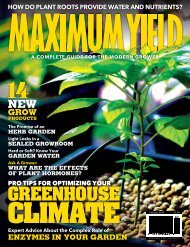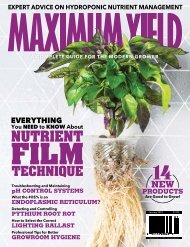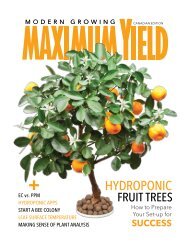Maximum Yield Modern Growing | Canadian Edition | May June 2017
In this issue of Maximum Yield, we cast a wide net to bring you the best and latest information possible to help you get started growing your own food. From the basics like cleaning your equipment to the best methods for preparing your plants to live outdoors, to more advanced topics like lighting and nutrient delivery, there is something in this issue for all levels of grower.
In this issue of Maximum Yield, we cast a wide net to bring you the best and latest information possible to help you get started growing your own food. From the basics like cleaning your equipment to the best methods for preparing your plants to live outdoors, to more advanced topics like lighting and nutrient delivery, there is something in this issue for all levels of grower.
You also want an ePaper? Increase the reach of your titles
YUMPU automatically turns print PDFs into web optimized ePapers that Google loves.
feature<br />
nutrient name application systems<br />
DESIGN AND LAYOUT<br />
Layout also affects the distribution of<br />
nutrient solution to individual plants<br />
around a drip irrigation system. Drip<br />
systems may consist of either inline or<br />
microtube systems. Inline systems are<br />
more suited to large media beds where<br />
the emitters are directly attached to<br />
or embedded in the irrigation supply<br />
pipe, which runs down the centre of the<br />
bed. Microtube systems use tubing of a<br />
smaller diameter, which is installed into<br />
the lateral irrigation lines with emitters<br />
or drippers fixed on the end. Each plant<br />
or growing container can have one or<br />
two microtubes with emitters pegged<br />
into the substrate near the base of plant.<br />
Using microtubes allows a more uniform<br />
pressure at the emitters, provided the<br />
irrigation is correctly designed and has a<br />
pump of sufficient capacity.<br />
One of the main issues encountered<br />
by hydroponic growers is the differences<br />
in volume of nutrient solution<br />
received by plants in various parts<br />
of the drip system. Some plants may<br />
end up overwatered while others are<br />
constantly too dry, and these issues<br />
become difficult to remedy once<br />
the irrigation system is in place. To<br />
achieve uniform and constant nutrient<br />
flow rates to all emitters in the<br />
system, a ring or loop layout can be<br />
installed. This consists of emitters<br />
placed into lateral irrigation pipes<br />
connected at both ends to a ring main<br />
system, evening out the flow and<br />
pressure round an irrigation system.<br />
Each ring main is supplied by a main<br />
irrigation pipe running directly from<br />
a pump or pressure water supply.<br />
This largely prevents the issue of<br />
plants furthest away from the pump<br />
receiving the lowest volume of nutrient<br />
solution at each irrigation.<br />
Selecting the correct irrigation pipe<br />
diameter is an aspect of hydroponic<br />
system design that is often overlooked.<br />
The type, number, and flow rate of the<br />
irrigation emitters determine the size of<br />
irrigation lateral pipe needed in terms<br />
of flow rate and pressure required. As<br />
such, if the flow of nutrient appears too<br />
low from some emitters, it is often more<br />
effective to increase the diameter of the<br />
delivery pipes rather than invest in a<br />
more powerful pump. A large capacity<br />
pump will not compensate for irrigation<br />
pipes that are too small to carry the<br />
nutrient solution flow rate required.<br />
Float or raft systems may seem like a simple way<br />
to supply nutrient solution, but oxygenation, EC,<br />
and pH still need careful control.<br />
Growers setting up hydroponic systems<br />
for the first time or renovating an established<br />
indoor garden to improve nutrient<br />
management and delivery need to take<br />
solution flow and delivery into consideration.<br />
Under- or overwatering of individual<br />
plants, slow or insufficient flow rates<br />
in NFT systems, and inaccurate dosing<br />
can all be prevented with the correctly<br />
designed irrigation system.<br />
36 feature


















